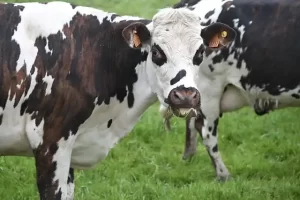Gut Bacteria Enzymes Offer Hope for ABO Universal Blood Transfusions
- “Miracle Weight-Loss Drug” Sweeps Across America
- The United States Avian Influenza Outbreak Worse Than Expected?
- Global First: Bovine Avian Influenza Transmission to Humans Detected
- Potassium-Enriched Salt Substitutes: Reducing Blood Pressure Risk?
- Tritium Detection in Fukushima’s Seawater: Below Safety Standards
- What Reason Let AstraZeneca Withdraws COVID Vaccine From The Market?
Gut Bacteria Enzymes Offer Hope for ABO Universal Blood Transfusions
- AstraZeneca Admits for the First Time that its COVID Vaccine Has Blood Clot Side Effects
- Was COVID virus leaked from the Chinese WIV lab?
- HIV Cure Research: New Study Links Viral DNA Levels to Spontaneous Control
- FDA has mandated a top-level black box warning for all marketed CAR-T therapies
- Can people with high blood pressure eat peanuts?
- What is the difference between dopamine and dobutamine?
- How long can the patient live after heart stent surgery?
Gut Bacteria Enzymes Offer Hope for ABO Universal Blood Transfusions
Global Blood Supply Shortage May See a Turning Point! Enzymes from this Probiotic Can Generate ABO Universal Blood.
Every year, millions of people require blood transfusions due to accidents, illnesses, or surgeries, but the available blood supply falls short of the demand. According to statistics, three people in the world need a blood transfusion every second, making ensuring clinical blood supply a matter of life and death. However, the blood supply-demand relationship in many countries has long been tense, and blood shortage remains a global issue.
The ABO system is a major immune barrier in transfusions. Matching the ABO antigens on red blood cells (RBCs) and the antibodies in the plasma of donors and recipients is crucial to avoid potential lethal reactions during transfusions. Currently, among the four common blood types in humans, only individuals with type O blood are considered “universal donors.” Therefore, the stockpiling of universal O-type blood provides an attractive solution to blood shortages, and scientists are eager to break the limitations in the field of transfusions through technological means.
On April 29, 2024, researchers from the Technical University of Denmark and other institutions published an article in the journal Nature Microbiology titled “Akkermansia muciniphila exoglycosidases target extended blood group antigens to generate ABO-universal blood.” Their research found that a combination of exoglycosidases from the gut symbiotic bacterium Akkermansia muciniphila (referred to as AKK) can effectively convert A and B antigens and their extended antigens.
Compared to the conversion of A or B antigens alone, enzymatically removing the typical and extended ABO antigens from RBCs significantly improved compatibility with O-type plasma. Thus, this study demonstrates the potential of gut bacteria in producing universal blood for transfusions and offers hope for alleviating blood shortages in the future.

Key Research Findings:
1. AKK enzymes remove B antigens and their extended antigens from RBCs.
Researchers began by selecting candidate enzymes to remove B antigens and their extended antigens (ExtB). Based on relevant literature and comparisons with a benchmark B antigen cleaving enzyme, they identified AmGH110A, AmGH36A, AmGH36C, and AmGH27 from AKK. They then evaluated the efficiency of AmGH110A, AmGH36A, AmGH36C, and AmGH27 in converting B antigens on RBCs from three random donors in a conversion buffer. The results showed that AmGH110A displayed higher efficiency in depleting B antigens on RBCs. They also studied how ExtB affects the removal of B antigens and found that the presence of N-acetylgalactosamine (GalNAc) caps in ExtB hindered the removal of B antigens by AmGH110A. Through experiments, they found that the sequential or mixed use of AmGH110A and AmGH20A was required to deplete both B and ExtB antigens, highlighting the importance of removing ExtB for the conversion of B antigens.
2. AKK enzymes remove A antigens and their extended antigens from RBCs.
Using the same strategy, they evaluated the efficiency of AKK enzymes in removing A antigens and their extended antigens from RBCs. The results showed that AmGH109A had the lowest activity, followed by AmGH109B, while AmGH36A exhibited the highest efficiency. By varying the incubation time and enzyme concentration, they found that 0.5 μM AmGH36A was sufficient to completely convert A antigens from three donors’ RBCs within 30 minutes. Additionally, they found that AmGH95B and AmGH35A were most efficient in removing A extended antigens.
3. Extended antigens are crucial for the compatibility of RBCs with O-type plasma.
Both for B antigens and A antigens, the team studied their extended antigens. How does the removal of the latter affect cross-reactivity? Researchers used ten randomly selected O-type plasma with strong reactions to B-type RBCs as a baseline. They found that using AmGH110A to treat B-type RBCs significantly reduced but did not completely eliminate reactivity. Furthermore, compared to using AmGH110A alone, using a combination of AmGH110A and AmGH20A further significantly reduced reactivity. They then used a similar method to study the removal of A antigens and their extended antigens, and the results similarly showed that a mixture of AmGH36A, AmGH95B, and AmGH35A treatment could further significantly reduce average reactivity.
4. Structural features of AmGH110A and AmGH20A in action.
The study found that the combined use of AmGH110A and AmGH20A significantly improved the compatibility between B-type RBCs and O-type plasma. What is the structural basis for their action? Researchers analyzed the structure of AmGH110A and found that it had an additional N-terminal CBM51. The active site at the +1 subsite of AmGH110A is spacious, allowing for the accommodation of the fucosylated glycans of the H antigen. Apart from the atypical presence of CBM51 in AmGH110A, its surface topology and charge represent potential important adaptations to promote the catalytic efficiency towards sialylated glycans on RBCs. Therefore, the active site of AmGH110A is flanked by flat, positively charged surfaces, consistent with the highest isoelectric point in known B antigen-active enzymes.
Similar to AmGH110A, the active sites of AmGH20A are flanked by flat, positively charged surfaces. Notably, the second N-acetylglucosamine binding unit is located in a shallow site within the β-sandwich domain at the C-terminus of AmGH20A. The observed N-acetylglucosamine binding suggests that this domain is a carbohydrate-binding module (CBM), and this CBM binding site has solvent-accessible tyrosines (Y590), two histidine residues (H595 and H623), and an arginine (R619).
In conclusion:
This study identified efficient enzymes for converting A and B antigens, providing endless hope for producing ABO universal blood for transfusions and potential organs for transplantation. Additionally, the study found that extended A and B antigens are important factors affecting the compatibility of A-type and B-type RBC transfusions and highlights the gut microbiota as an important reservoir of human glycan-active enzymes.
Gut Bacteria Enzymes Offer Hope for ABO Universal Blood Transfusions
Reference:
Mathias Jensen, et al. Akkermansia muciniphila exoglycosidases target extended blood group antigens to generate ABO-universal blood. Nature Microbiology. (2024).
(source:internet, reference only)
Disclaimer of medicaltrend.org
Important Note: The information provided is for informational purposes only and should not be considered as medical advice.



